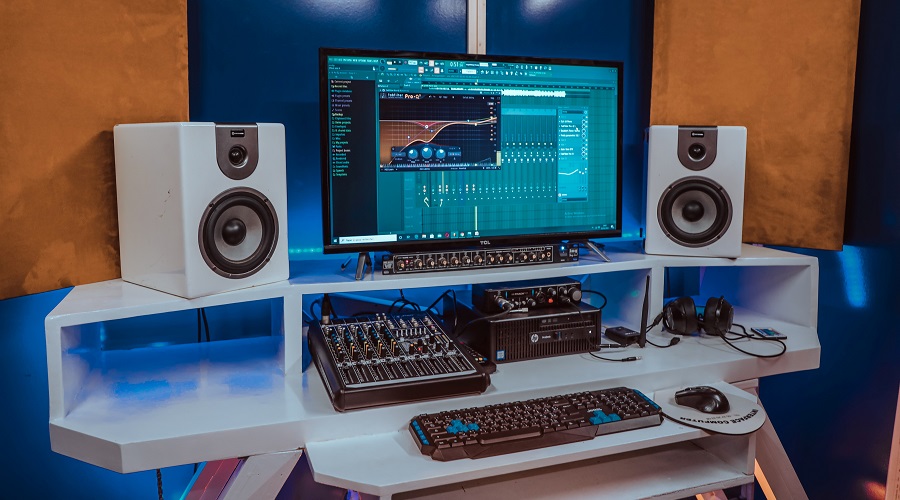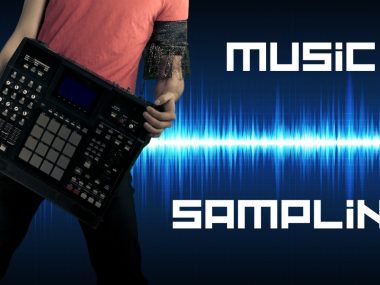Could you possibly imagine that four simple parameters can change the timber of your music?
Well, envelopes are handy tools that music producers synthesize music characters that replicates real instruments.
What is an envelope, and why does it matter this much in the world of audio editing?
Let’s find out!
What Is an Envelope in Music?
Envelopes (contour generators) are ways to shape music waves into a more realistic form by contouring different parameters like attack, decay, sustain, and release.
The most common envelope is the ADSR working along with a voltage-controlled analog synthesizer.
ADSR Envelope Phases
A typical envelope has four phases ordered according to their sequence: attack, decay, sustain, and release.
On a synthesizer interface, you’ll find four knobs or sliders that you can use to adjust each phase.
Let’s take a look at what these envelope components actually mean in terms of music editing:

Attack Time
On a musical note, the attack is how long the build-up phase takes before reaching its peak amplitude.
The attack portion of the envelope graph starts once the triggering key is pressed and ends with the peak point.
However, with an inverted ADSR envelope, the attack begins with maximum till it fades down to nil.
Decay Time
Once the amplitude reaches its peak at the end of the attack time, it begins declining every so slightly before coming to a plateau phase. This declining slope is known as the decay time.
Sometimes, the word decay can also be used to describe a fading volume that goes to nil, but that’s not the case when we’re talking about envelopes.
Sustain Level
The sustained plateau is usually the envelope phase that’s wide enough to influence the amplitude level for the note.
Keep in mind that not every instrument is going to have a sustain in its graphical representation, but we’ll talk about atypical envelopes later.
Release Time
The release phase starts once you remove your hands from the triggering key and goes on till the sound fades completely.
The release slope looks a lot like the decay one. However, the decay precedes the sustain, while the release precedes silence.
Atypical Envelopes
Aside from the typical ADSR sequence, you can use other variations depending on the instrument and musical style.
Phases can be repeated or eliminated entirely as you customize your envelope to your liking, but it takes a bit of skill to know what timber each envelope is good for.
Let’s take a look at some of these atypical sequences here:
Inverted Envelope
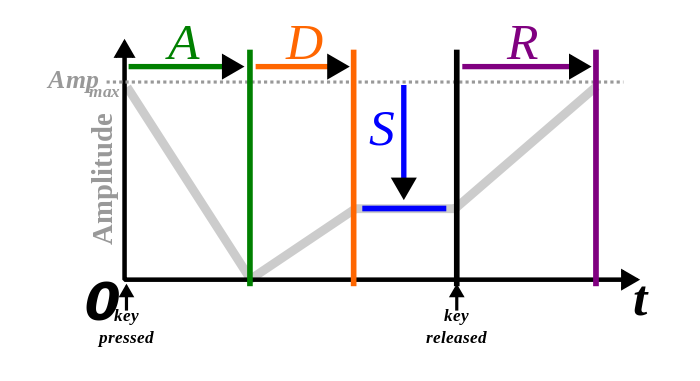
Unlike what you may think, an inverted envelope isn’t an RSDA sequence. Instead, it reverses the normal flow of the ADSR values as if you mirrored the wave graph upside down.
For instance, the inverted attack goes from maximum to silence. Meanwhile, the decay phase looks like a gradual rise in volume till the note amplitude reaches a plateau, and so on.
The Juno and DM12 synthesizers can invert envelopes to create nice closures for the bass filters on the microbrute.
If your synth doesn’t have the inverted envelope option, you have to settle for a Krell patch, which doesn’t have the same appeal.
ADBDSR Envelope
The ADBDSR sequence is much more complex than a typical envelope with on an attack, decay, breakpoint, decay again, sustain, and release.
The breakpoint here cuts the decay slope into two phases. This complexity helps provide a realistic amplitude.
You also use a breakpoint to cut up any phase of the typical ADSR sequence to contour the envelope to your liking.
AHDSR Envelope
The atypical AHDSR envelope follows a modified sequence: attack, hold, decay, sustain, and release.
The extra hold phase helps you decide how long you want the note to hold its maximum value after the attack and before it falls into the decay slope.

It’s often thought of as an early sustain plateau that you can adjust by manipulating the attack peak and the decay starting point. Meanwhile, a sustain phase usually isn’t that easy to set.
DADSR Envelope
Some synthesizers give you the option to add an extra decay before the attack point in a sequence of DADSR.
You can use this envelope sequence with a low-pass filter cutoff to create a muted sound before the note starts peaking in a cleaner sound.
In synthesis with this five-mode style, you can adjust the first decay value to zero if you want a typical ADSR envelope.
DAHDSR Envelope
On some envelope generators, you can find six control options that add an initial decay before the attack and follow it up with a hold phase before the main decay.
On other synthesizers that lack the DAHDSR envelope, like the Roland TVA, you can manipulate the existing features to replicate the decay, attack, hold, decay, sustain, and release sequence.
This envelope sequence can be used to replicate the effect of after-touching, and it also works nicely for ambient tracks.
AD Envelope
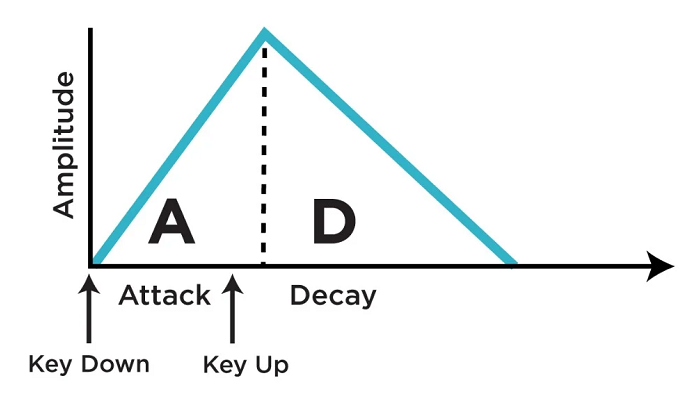
Another atypical envelope is the attack and decay only sequence. The two-phased AD envelopes are mainly useful for controlling one feature, like the pitch, on a single oscillator.
Sometimes, you’ll notice a variation of this envelope by replacing the delay with a release since both phases represent a decline in amplitude.
Plus, an AR envelope uses a trigger to close the cycle, while the AD uses a gate that declines once the volume reaches its high state, regardless of the input.
Multi-Segment Envelope
Some synthesizers support Multi-Segment Envelope Generators that are abbreviated to MSEG.
These generators allow you to create complex envelopes with any number of phases and breakpoints you wish to use.
The final result, which can be linear or curved, is synced to the tempo grid to touch up the rhythm pattern.
Using an MSEG can be tricky, especially for beginners, but it offers a larger room for customization and leaves things up to your creativity.
Shapes of Musical Envelopes in Common Instruments
Every musical instrument has its own set of envelope values, phases, and breakpoints that give its unique sound. That much we’ve covered.
You can see shapes like trapezoids, rectangles, triangles, and even cosine curves, depending on the instrument you’re trying to replicate.
Trapezoidal Envelope
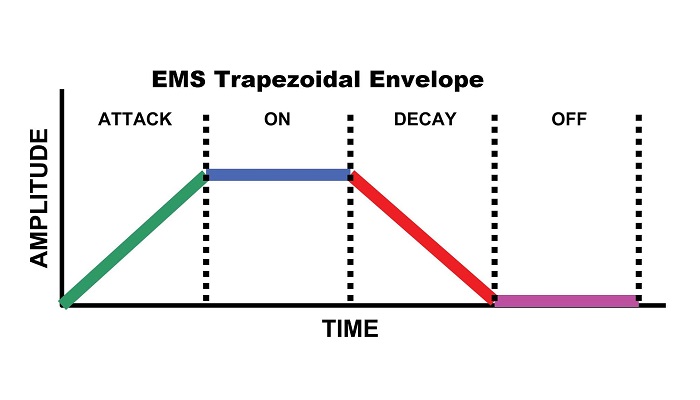
It’s easy to spot this envelope shaping in many wind instruments like the trombone, bass clarinet, bass flute, and bass trumpet. Overall, the trapezoid style is very common in electro music or EMS.
Rectangular Envelope
Another shape that you can come across is the rectangular envelope that usually represents instruments with mechanical movements. Take, for instance, the opening and closing of an organ pipe.
Triangular Envelope
A musical envelope with a triangular graph has one prominent peak that slopes up and down in steep slopes. You can spot this particular shape in instruments that are plucked or struck, like the piano, guitar, and dulcimers.
FAQs
Now that we’ve covered the basics, let’s jump into some frequently asked questions about envelopes in music:
Q: How to choose a height scale for your envelopes?
A: Normally, the default scale for an envelope is 1 to 100. This means that each note has a ceiling that goes up to MIDI note 100.
However, you can always just set the automatic scale to customize the height from your lowest and highest MIDI note available on the track.
Q: What Playback speed works best for ADSR envelopes?

A: MIDI envelopes work by ripping the track and creating an XML file of the played notes. So, you can increase the processing time.
However, in increasing the speed, you risk losing the resolution. That’s why I recommend starting from the normal speed and building your way up gradually.
Q: What envelope peaks affect the volume level?
A: To get any noticeable increase in volume, you need to depend on sustained amplitude since the RMS value of longer peaks is what controls the amplification process.
On the other hand, a short peak would contribute more to the character or the timbre of the sound. That’s why envelope parameters can help replicate the timbre of real instruments.
Q: Can you use envelopes without amplifiers?
A: No, regardless of the envelope shape, it only creates sounds through controlling an amplifier to open up and produce louder notes.
If you don’t hook up any amplifiers, you won’t get to hear any sounds even after adjusting your ADSR phases.
Q: How to replicate natural decay?
A: If you keep your ears out for decay patterns in real-life instruments, you’ll notice that the notes with higher frequencies decay faster than the lower-end ones.
The reason why this happens is that sound with higher frequencies loses energy in a faster dissipating pattern.
Q: How can you use the graph points between envelope phases?

A: If your synthesizer envelope interface has between points, you can move them up and down to adjust the curvature of your slopes.
I would recommend trying out both the convex and concave to compare them to the typical linear line and see which suits your track’s style better.
